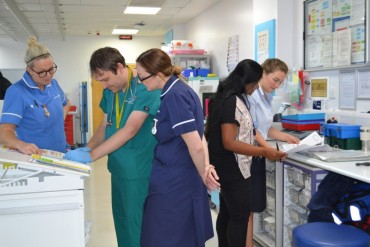Fever in children
Fever is extremely common in young children and usually suggests that your child has an infection. If your child’s temperature is over 38ºC, they have a fever. Measure the temperature in the ear or under the arm using a digital thermometer.
Viral infections are more common than bacterial infections. Symptoms such as runny nose, cough and sore throat are more indicative of a viral infection. If a number of people in the same household are unwell, this suggests a viral infection (as they are easily spread).
Viral infections usually get better on their own and do not need antibiotics to be treated.
If your child has any of the following:
• Pale, mottled skin that feels abnormally cold to touch
• Bluish lips indicating a lack of oxygen in the blood
• Severe difficulty breathing, unable to talk, eat or drink
• Fit or seizure
• Extreme agitation or confusion, or excessive lethargy
• Non-blanching rash that doesn’t disappear with pressure
• Infants under 3 months with a temperature of 38ºC or higher (unless following vaccinations within 48 hours)
YOU NEED URGENT HELP
GO TO THE NEAREST HOSPITAL EMERGENCY (A&E) DEPARTMENT OR PHONE 999
If your child has any of the following:
• Struggles to breathe
• Shows signs of dehydration (sunken eyes, drowsiness, no urine for 12 hours)
• Becomes excessively drowsy or irritable (despite fever reduction)
• Experiences severe shivering or muscle pain
• Maintains a fever of 38ºC or higher for over 5 days
• Shows worsening symptoms or causes concern
YOU NEED TO CONTACT A DOCTOR/NURSE TODAY
PLEASE RING YOUR GP SURGERY OR CALL NHS 111 – DIAL 111
If none of the above features are present:
SELF CARE
USE THE ADVICE HERE TO PROVIDE THE CARE YOUR CHILD NEEDS AT HOME
For your distressed child:
• Consider using paracetamol or ibuprofen for comfort
• Use one medication and if no improvement after 2-3 hours, then try the other
• Follow medicine instructions for dose and frequency
Perform the “glass test” on your child’s rash by firmly pressing a glass tumbler against it. If the spots are visible through the glass and do not fade when pressure is applied, it is a “non-blanching rash”. If you observe this type of rash, seek immediate medical advice. Note that the rash may be less visible on dark skin, so check paler areas like the palms, soles and tummy.
• Ensure comfort, consider giving paracetamol or ibuprofen
• Encourage regular fluid intake (not sugar free)
• For breastfeeding babies, continue breastfeeding
• Offer small frequent drinks if vomiting occurs
• Avoid tepid sponging or fans to control temperature
• Monitor your child closely, follow provided guidance
• Conduct the “glass test” if a rash appears
• Fever post-immunisation may be normal for up to 48 hours, give regular paracetamol
• Notify nursery/school if keeping your child at home due to illness/fever



